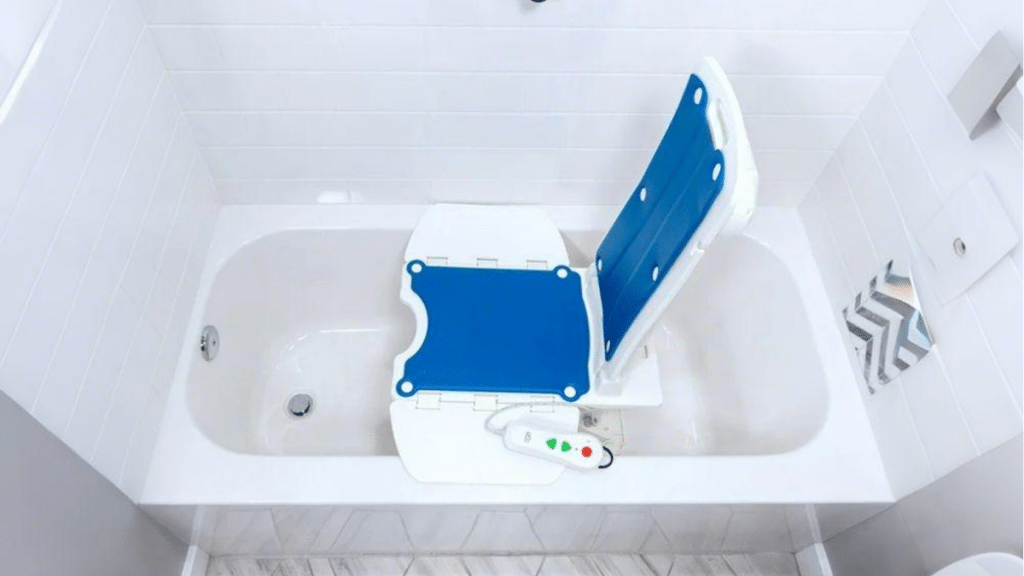If you have mobility issues, being able to navigate the bathroom safely is important. Lift chairs or transfer stools are popular solutions for enhancing bathroom accessibility, and each can meet different needs. In this article, we’ll compare these devices, outlining their key differences, benefits, and important considerations to help you make an informed choice for a safer, more comfortable bathroom experience.
What Is a Lift Chair?
A lift chair is a recliner with an electric mechanism that helps you sit down and stand up with ease. It gently tilts forward, reducing strain on your joints and muscles, making it perfect for anyone with mobility challenges. Lift chairs offer comfort and support, with adjustable reclining positions that allow you to relax and move with ease.
What Is a Transfer Bench?
A transfer bench is a bathroom aid designed to help you safely move in and out of the bathtub. It has a long, sturdy frame that spans the edge of the tub, with one side sitting outside and the other inside. This setup allows you to sit on the outside and then slide across the bench into the tub, reducing the risk of slips or falls. Transfer benches are especially helpful if you have limited mobility, providing a stable and secure way to transition between the tub and the bathroom floor.
Key Differences Between Lift Chairs and Transfer Benches
Functionality
- A lift chair is designed to assist users in sitting down and standing up. It provides powered support and can be used not only in bathrooms but also in other parts of the home. This feature makes it more versatile, especially for people who need assistance throughout their daily routines, not just during bathing.
- On the other hand, a transfer bench is specifically intended for use in and around the bathtub. It helps individuals slide safely in and out of the tub without risking a fall. While it doesn’t help you sit or stand, it does make the process of transferring into the tub much easier.
Design and Space Requirements
- Lift chairs generally have a smaller footprint and can be placed next to a toilet, shower, or bathtub. They require electrical power to function and may take up a bit of space in the bathroom, but they provide additional comfort due to their cushioned seating and armrests.
- Transfer benches tend to be longer, as they need to extend across the bathtub and onto the floor. While they may not require electricity, they do require space across the bathtub area. For smaller bathrooms, fitting a transfer bench may be more challenging, especially if there’s limited room next to the tub.
Comfort and Convenience
- Lift chairs typically offer greater comfort than transfer benches. They are equipped with cushioned seats, adjustable armrests, and a reclining backrest, allowing users to sit for extended periods without discomfort. Additionally, bath chair lifts help users sit and stand with less strain on their muscles and joints, offering enhanced convenience for people with limited mobility.
- Transfer benches are generally more utilitarian and less focused on comfort. While they offer a stable surface for transferring, they may not provide the same level of comfort, as they are typically made of hard plastic or metal.
Safety Features
- Lift chairs provide a greater degree of safety for people with limited mobility as they reduce the effort required to sit down or stand up. Electric lifts ensure that users can sit, stand up, or transfer to a wheelchair without injury, which is particularly beneficial for people with arthritis, muscle weakness, or joint pain.
- Transfer benches focus on safety during the transferring process. They are equipped with non-slip legs and a wide, stable seat to ensure users can slide across the tub edge without losing their balance.
Cost and Maintenance
- Lift chairs tend to be more expensive due to their electric components and advanced features. They may also require more maintenance, especially when it comes to battery charging and electrical parts.
- Transfer benches are much more affordable, with prices typically ranging from a few dozen to a few hundred dollars. They are easy to maintain, requiring only occasional cleaning and ensuring that the non-slip feet remain in good condition.
Which Option Is Right for You?
For Individuals with Severe Mobility Limitations
If you have significant difficulty standing up or sitting down, a lift chair may be the better choice. It offers automated support that minimizes the strain of these actions. A bath chair lift can be especially helpful if you also have difficulty moving from a seated position to a standing one.
For Those Who Have the Space for Larger Equipment
If you have a spacious bathroom, a transfer bench may be the ideal option. However, if you require a chair that provides more overall mobility assistance, then a lift chair may be a better fit.
For Those on a Budget
If cost is a major concern, a transfer bench offers an affordable option without sacrificing functionality. While it may not provide the same level of comfort or assistance as a lift chair, it is still a reliable solution for users with less severe mobility limitations.
For Those Seeking Easy Maintenance
If you prefer a low-maintenance option, a transfer bench would be the better choice. It doesn’t require electrical power and has fewer parts to maintain, making it more convenient for those who don’t want to worry about technical upkeep.
Conclusion
Choosing between a lift chair and a transfer bench depends on your mobility needs. If you need extra support with sitting and standing, a lift chair—or bath chair lift—can provide you with comfort and safety. On the other hand, a transfer bench might be the better option if your primary concern is safely getting in and out of the bathtub. Consider your bathroom layout, mobility requirements, and budget to make the best choice, ensuring that your bathroom tasks are safer and more manageable.
